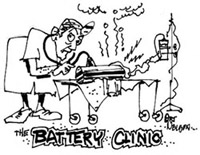The Ni-MH that are available to us today from Sanyo/Panasonic may be treated essentially the same as Ni-Cds –EXCEPT
FOR PEAK CHARGING. You have to be careful here. Some chargers will accommodate them, others won’t - and end up severely
overcharging them to the point of destruction.
In a given cell size Ni-MH has on the order of 20 to 30% more capacity
than Ni-Cds. They have slightly higher internal resistance, but not enough to concern us in most R/C control applications.
This higher internal resistance can be of concern in electric flight operations where it is common practice to add an additional
cell to compensate. They have a shorter cycle life in general, but again not enough to be of real concern. Most people run
out of calendar life before cycle life in flying R/C. Meaning that the separator system in the battery (same for both types)
fails (shorts) before the cells fade away in capacity delivery ability. Ni-MH are less tolerant to abuse (excessive high rate
discharge, excessive overcharge, vibration, cell reversal) than Ni-Cd – but again, it seldom becomes an issue if reasonable
care is given in the installation and maintenance of the packs. Ni-MH capacity falls off with cycling whereas Ni-Cd
stays pretty constant, seldom going below 80% before shorts develop. Ni-MH has a higher self-discharge rate (3-4%/day)
than Ni-Cd (1%/day). Ni-MH cost a bit more per Ah of capacity.
Red S.
Red’s R/C Battery Clinic
Updated 2/04

